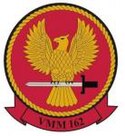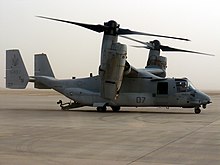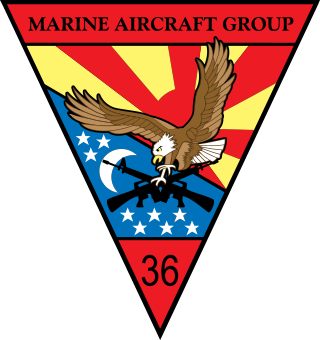
Marine Aircraft Group 36 (MAG-36) is an active air group of the United States Marine Corps, tasked with providing assault support aircraft. It is currently part of the 1st Marine Aircraft Wing, itself an integral part of the III Marine Expeditionary Force, and based at Marine Corps Air Station Futenma in Okinawa, Japan.

Marine Medium Tiltrotor Squadron 262 (VMM-262) is a United States Marine Corps tiltrotor squadron consisting of MV-22B Osprey tiltrotor aircraft. The squadron, known as the "Flying Tigers", is based at Marine Corps Air Station Futenma, Okinawa, Japan and falls under the command of Marine Aircraft Group 36 (MAG-36) and the 1st Marine Aircraft Wing.

Marine Medium Tiltrotor Squadron 261 (VMM-261) is a United States Marine Corps tiltrotor squadron consisting of MV-22 Osprey transport aircraft. The squadron, known as the "Raging Bulls", is based at Marine Corps Air Station (MCAS) New River, North Carolina and typically falls under the command of Marine Aircraft Group 26 (MAG-26) and the 2nd Marine Aircraft Wing. They are the fourth squadron in the Marine Corps to transition to the MV-22 Osprey.

Marine Medium Tilt Rotor Squadron 165 (VMM-165) is a United States Marine Corps Tilt-rotor squadron consisting of MV-22B Osprey transport aircraft. The squadron, known as the "White Knights", is based at Marine Corps Air Station Miramar, California and fall under the command of Marine Aircraft Group 16 (MAG-16) and the 3rd Marine Aircraft Wing.

Marine Medium Tiltrotor Squadron 161 (VMM-161) is a United States Marine Corps tiltrotor squadron that operates the MV-22 Osprey. The squadron, known as the "Greyhawks", is based at Marine Corps Air Station Miramar, California and falls under the command of Marine Aircraft Group 16 (MAG-16) and the 3rd Marine Aircraft Wing. The squadron has the distinction of being the first helicopter transport squadron in the world and regularly utilizes the phrase "The First, The Best".

Marine Medium Tiltrotor Squadron 263 (VMM-263) is a United States Marine Corps tiltrotor squadron consisting of MV-22B Osprey transport aircraft. The squadron, known as the "Thunder Chickens", is based at Marine Corps Air Station New River, North Carolina and falls under the command of Marine Aircraft Group 26 (MAG-26) and the 2nd Marine Aircraft Wing.

Marine Aircraft Group 16 is a United States Marine Corps aviation unit based at Marine Corps Air Station Miramar that is currently composed of four V-22 Osprey squadrons, four CH-53 Super Stallion squadrons, one Personnel Support Detachment, and an aviation logistics squadron. The group falls under the command of the 3rd Marine Aircraft Wing and the I Marine Expeditionary Force.

Marine Medium Tiltrotor Squadron 268 (VMM-268) is a United States Marine Corps helicopter squadron consisting of MV-22 transport. The squadron, known as the "Red Dragons", is based at Marine Corps Base Hawaii, Kaneohe, Hawaii and falls under the command of Marine Aircraft Group 24 (MAG-24) and the 1st Marine Aircraft Wing.

Marine Medium Tiltrotor Squadron 774 (VMM-774) is a United States Marine Corps medium tiltrotor squadron consisting of V-22 Osprey tiltrotor aircraft. The squadron, known as the "Wild Goose", is a United States Marine Corps Reserve unit based at Marine Corps Air Station New River, North Carolina and falls under the command of Marine Aircraft Group 49 (MAG-49) and the 4th Marine Aircraft Wing.
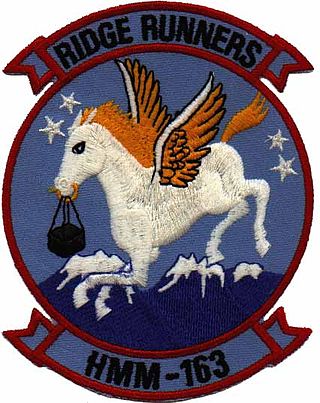
Marine Medium Tiltrotor Squadron 163 (VMM-163) is a United States Marine Corps helicopter squadron consisting of MV-22 Osprey transport tiltrotors. The squadron, known as "Evil Eyes", is based at Marine Corps Air Station Miramar, California and falls under the command of Marine Aircraft Group 16 (MAG-16) and the 3rd Marine Aircraft Wing.
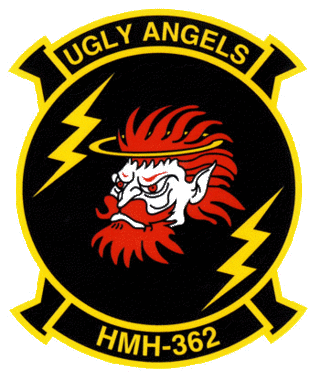
Marine Medium Tiltrotor Squadron 362 (VMM-362) is a United States Marine Corps squadron that operates MV-22 Osprey. The squadron, known as the "Ugly Angels", was reactivated on 17 August 2018 at Marine Corps Air Station Miramar, California.
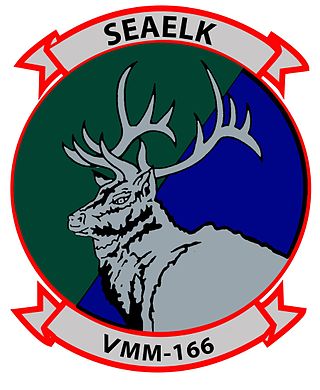
Marine Medium Tiltrotor Squadron 166 (VMM-166) was a United States Marine Corps tiltrotor squadron consisting of MV-22 Osprey transport aircraft. The squadron, known as the "SeaElk", was last based at Marine Corps Air Station Miramar, California. Activated in 1985, HMM-166 was the youngest CH-46 helicopter squadron in the Marine Corps. The squadron was redesignated as a tiltrotor squadron on 23 June 2010. The squadron was deactivated on 1 October 2021.

Marine Medium Tiltrotor Squadron 266 (VMM-266) is a United States Marine Corps tiltrotor squadron consisting of MV-22 Osprey transport aircraft. The squadron, known as the "Fighting Griffins", is based at Marine Corps Air Station New River, North Carolina falls under the command of Marine Aircraft Group 26 (MAG-26) and the 2nd Marine Aircraft Wing.

Marine Heavy Helicopter Squadron 461 (HMH-461) is a United States Marine Corps helicopter squadron consisting of CH-53K King Stallion transport helicopters. The squadron, known as "Ironhorse", is based at Marine Corps Air Station New River, North Carolina and falls under the command of Marine Aircraft Group 29 (MAG-29) and the 2nd Marine Aircraft Wing. With its lineage starting in 1944, HMH-461 is the oldest active Heavy Lift Helicopter Squadron in the Marine Corps.

Marine Medium Tiltrotor Squadron 264 (VMM-264) was a United States Marine Corps tiltrotor squadron consisting of MV-22 Osprey transport aircraft. The squadron, known as the "Black Knights", was based at Marine Corps Air Station New River, North Carolina, and normally fell under the command of Marine Aircraft Group 26 (MAG-26) and the 2nd Marine Aircraft Wing. They were the last east coast CH-46 Sea Knight squadron to transition to the Osprey. VMM-264 was decommissioned on 24 June 2020.
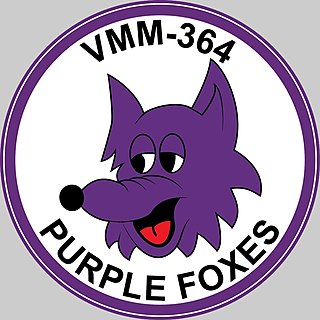
Marine Medium Tiltrotor Squadron 364 (VMM-364) is a United States Marine Corps medium-lift tiltrotor squadron consisting of MV-22B Ospreys. The squadron, known as the "Purple Foxes", is based at Marine Corps Air Station Camp Pendleton, California and falls under the command of Marine Aircraft Group 39 (MAG-39) and the 3rd Marine Aircraft Wing.

Marine Medium Tiltrotor Squadron 365 (VMM-365) is a United States Marine Corps tiltrotor squadron consisting of MV-22B Osprey transport aircraft. The squadron, known as the "Blue Knights", is based at Marine Corps Air Station New River, North Carolina and falls under the command of Marine Aircraft Group 26 (MAG-26) and the 2nd Marine Aircraft Wing.

Marine Medium Tiltrotor Squadron 164 (VMM-164), is a United States Marine Corps tiltrotor squadron operating the MV-22B Osprey. Known as the Knightriders, they fall under the command Marine Aircraft Group 39 (MAG-39) and the 3rd Marine Aircraft Wing. They are based at Marine Corps Air Station Camp Pendleton.

Marine Medium Tiltrotor Squadron 363 (VMM-363) is a United States Marine Corps tiltrotor squadron consisting of MV-22B Ospreys. The squadron, known as the "Lucky Red Lions", is based at MCB Hawaii and falls under the command of Marine Aircraft Group 24 (MAG-24) and the 1st Marine Aircraft Wing.

Operation Shufly was a United States Marine Corps operation to improve the mobility of Army of the Republic of Vietnam (ARVN) forces in the early phases of the Vietnam War from 1962 to 1965. Beginning on 15 April 1962, Marine helicopter squadrons, associated maintenance units and air traffic control detachments deployed to Sóc Trăng Airfield in the Mekong Delta and later to Da Nang Air Base rotating every four months in order to provide assault support and CASEVAC assistance during combat operations. By early 1965 half of the Marine Corps' medium helicopter squadrons had rotated through a "Shufly" deployment. The operation ended on 8 March 1965, when the 9th Marine Expeditionary Brigade came ashore in Vietnam as the vanguard of the United States' commitment of large numbers of regular combat units into South Vietnam.
